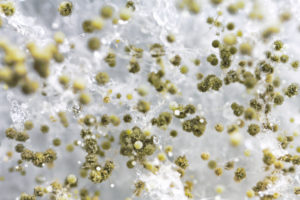How Does Mold Grow and Reproduce?

How Can Mold Spread So Fast?
In Mother Nature, mold aids decomposition. However in your home, it can wreak havoc indoors when it spreads, from structural damage to inhabitant health problems. Tricky to eliminate due to its various stages of growth, the NYC mold removal experts at Stern know the importance of selecting the right eradication method to prevent its proliferation.
How Does Mold Spread?
Mold has a four-stage life cycle, which treatment must reflect:
1. Hyper-Hungry Hyphae
Minute and threadlike, hypha cells feed on organic matter, absorbing nutrients and forming clusters – the visible evidence of mold. Like roots, they anchor mold to its substrate, providing nutrients. Wiping down surfaces does nothing to detract these cells from reproducing and returning.
2. Mighty Morphing Mycelium
The hyphae morph into mycelium. Reproducing asexually via cell division, spores appear on the end of each cell, spurred on based on light exposure, oxygen, and ambient temperature.
3. Sneaky Spreading Spores
The mycelium release microscopic spores into the air. Each species of spore is consistent in size, shape, color, and form, aiding identification. Like a seed, they drift until finding a surface with the ideal water and nutrient requirements. Unlike a seed, spores do not contain any preformed offspring. Tiny but tough, spores can remain dormant on surfaces for years until the right conditions develop for growth.
4. Perpetual Proliferation
The lifecycle of mold continues endlessly as the spores settle, grow, and continue to reproduce, taking their toll on the structure of your home and the health of your family over time.
Stop the insanity. Break the mold life cycle with the help of the NYC mold removal experts at Stern Mold today.
